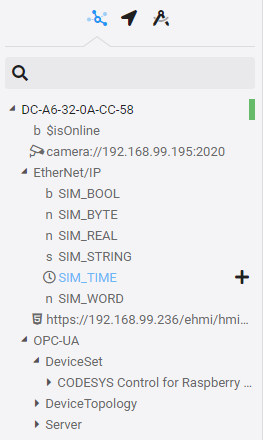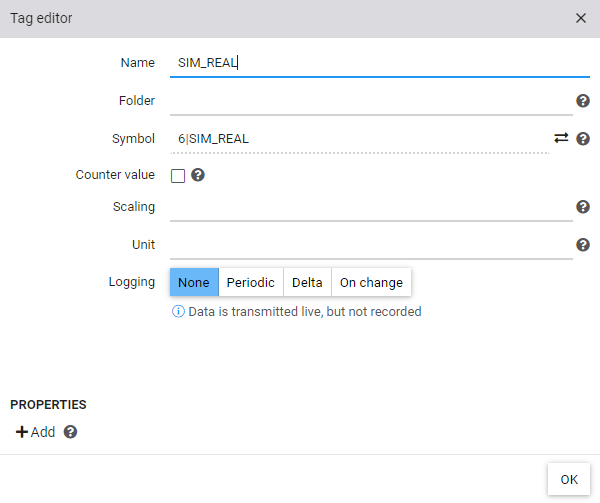Tags
A tag is a variable value used for display, monitoring or operation. This can be a variable of a PLC, a value of a counter or even a calculated tag. Each tag is available up to the second.
Data types
AnyViz supports the processing of the following data types:- Numeric: Integers or floating point numbers (also counter values).
- Boolean:
trueandfalsevalues for status display or acquisition of operating times - String: Display or input of texts
- DateTime: Date values, time values or combined date/time values
Create a tag
Once a cloud adapter is successfully connected, the list of available symbols is exchanged and displayed in a structured manner underneath in the tree.

When using a symbol for the first time or clicking on the icon, the tag editor appears.

Depending on the data type and cloud adapter, different properties can be defined.
| Name |
Display name, which is used for labeling purposes The name does not have to be unique and can be changed at any time |
| Folder |
Name of the folder (see structs / folders) Press the Enter key to enter nested folders |
| Symbol | Unique ID of the symbol. To change, see symbol exchange |
| Counter value | Enables meter reading for automatic determination of consumption/generation and power/throughput. See counter concept |
| Scaling | Allows conversion by specifying a Factor, as well as limiting values by specifying Min and Max. Click on the arrow to enable linear conversion (e.g. conversion of a 4-20mA signal). |
| Unit |
Unit for displaying the value For counter values, a deviating unit for the power/throughput is specified in addition to the unit for the consumption/generation (e.g. kWh;kW or m³;m³/h) |
| Logging | Configuration of optional data logging. |
| Properties | Each tag allows to store optional properties, which are displayed in the tooltip. These can also be used for filtering or can be displayed via a info field. |
Data logging
Tags can optionally be configured for data logging. The following options are available:
- Periodic: Logging at an interval between 10 seconds and 1 hour.
If the value remains unchanged over several logging periods, only the first and last period is persisted - Delta: The value is persisted as soon as it changes by a specified delta. This option makes it possible to accurately track value changes without requiring a larger logging capacity.
- On change: Each value change is persisted. This option is suitable for setpoints or states, but can lead to large amounts of logging if used incorrectly.
Tag source
Once a writable tag has been created, another tag can be configured as the source. To do this, drag a compatible tag from the tree into the Source field. Each change in the value of the source is then written to the target tag. In this way, control systems can be networked across locations.